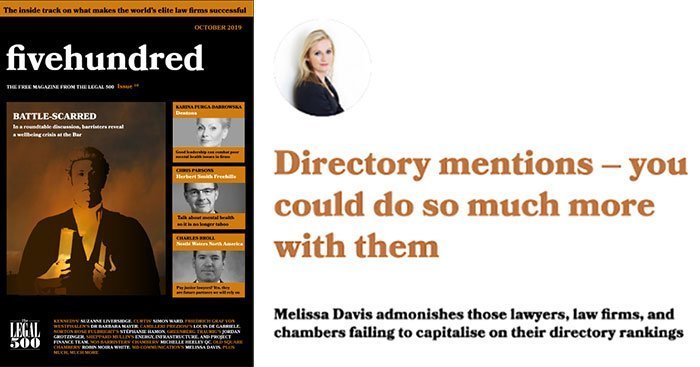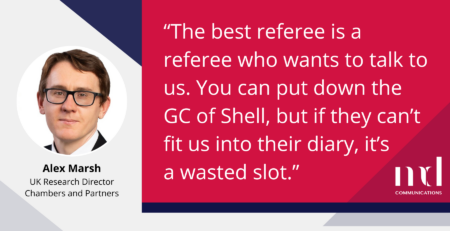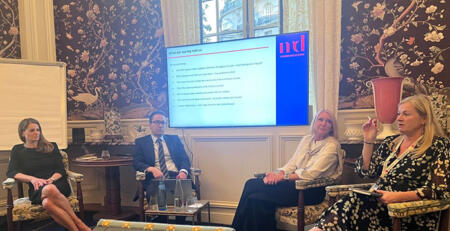Taking entries and interviews for the legal directories is a serious commitment by law firms and chambers. For many, the cost of supplementing an editorial mention with a firm or individual directory listing is dwarfed by the internal resource they have dedicated – perhaps a third of a marketing or PR staff member’s year and valuable fee earner time spent on providing submission information, seeking consent of clients to be contacted, and on interviews.
Shouldn’t all that be enough? Surely, if the directories are used, new instructions follow an entry? And if they are not used, instructions won’t follow, and you’ve learned not to make such an effort next year. In fact, if that’s your attitude, perhaps you shouldn’t bother with The Legal 500 and Chambers, because lawyers, firms and chambers who capitalise on a directory mention are doing more than that, and in many cases could go much further with good effect. If, like me, you follow a lot of lawyers on Twitter and are connected to them on LinkedIn, you’ll know that there are two events that see a real peak in activity. For (mostly) barristers, there is the list of new QCs, which for just over 100 counsel is the cue for much humble-bragging and back slapping.
The QC list is a bit of a ‘cosy’ event, but still manages to have quite a joyful air to it.
The other, a good couple of days for many more people, is the main directory listings. Here’s global firm DLA Piper’s chief global development officer, Erin Stone Dimry, on LinkedIn: ‘Proud to announce that 284 of our lawyers were recognized and 54 of our practices were ranked in The Legal 500 United States 2019.’
Or here’s Squire Patton Boggs (@SPB_Global) also on the launch of the US Legal 500: ‘In the latest @thelegal500 US legal directory, #TeamSPB’s Jaime Daddona and Carolina Mederos are both listed as Next Generation Lawyers #Legal500#NextGenerationLawyer #NextGeneration.
Individual lawyers pick out quoted comments about them made in the new directories, ‘humbly’ note their mum now thinks they’re a good lawyer… and so it goes on.
These spikes in activity stand out, not least for commercial firms, whose social media output can otherwise be a little, well, dull – commonly tweets from something like a company law seminar, links to lawyers’ articles and (a bit more dynamic) some charitable activity.
I think that is worth doing on the day – it’s a bit different, and differentiation is something all lawyers know that, in a competitive field, helps business. Some even eke it out over the year. ‘”Anthony Gold are very knowledgeable and impressive solicitors” #testimonialtuesday #testimonial #legal500,’ the south London firm tweeted.
‘What are you known for?’ is a question we should all be able to answer.
Of course, individual tweets and LinkedIn updates quickly fall down people’s news feeds.
So the sensible firm or chambers build good rankings, along with awards, into the ‘furniture’ of their marketing.
Take the website of the world’s oldest firm, Tunbridge Wells’s Thomas Snell & Passmore. This firm’s age of course gets top billing as a differentiator (‘Here for you since 1570’), but its directory ranking prowess is stressed all over its website. For every online lawyer and practice profile the firm can say it for, the firm has notes they are ‘The Legal 500, recommended lawyer’, ‘The Legal 500 Leading Firm’, or ‘Top Ranked Chambers UK 2019’.
Not all practice areas deliver headline cases or deals that can be mentioned, and here, directory mentions are especially useful to quote – giving professionals a more equal-looking write-up to colleagues who can reference their work and clients.
Here’s the online profile for employment partner Lisa Mayhew, global co-chair or Bryan Cave Leighton Paisner. ‘‘Work of this nature is always highly sensitive,’ the firm’s website notes, but is able to add Mayhew is ‘ranked as a “leading individual” in employment law since 2012 by legal directory Legal 500,’ and is ‘one of only two “eminent practitioners” in employment law in Chambers & Partners directory’.
Used well, such plaudits help build up a picture. Geraldine Ryan, head of office, Manchester, Hill Dickinson has a revolving spin block of accolades (‘Recognition and awards’), beside her professional profile, that includes directory mentions.
Thomas Snell & Passmore has a list of ‘awards, rankings and accreditations’ in its ‘About us’ section. The nice thing about this and Hill Dickinson’s approach is that the rankings and awards play the part of supporting each other in telling a story about the firm and its individuals.
‘X lawyer of the year’ seems validated by being ‘top ranked’ in a directory. Many include nominations and listings even where they were not top or didn’t win – something you might not do with each item in isolation, but put together, the message is, ‘well, they must have something to get all these notices!’.
So far, so good. But many firms and chambers are more timid than the examples I’ve given. I think they are missing out.
And off a quick search of my email in-box, lawyers generally aren’t picking up on one suggesting from the Legal 500’s editors – adding their recommendation in the directory to their email signature. They thus miss out on thousands of communications a year that, unlike other marketing efforts, they can be sure the recipient is reading.
Congratulations to all professionals who get a well-deserved ranking and mention in a respected directory. Most of you could, though, do so much more with the mention you worked so hard to get.
This article was originally published in The Legal 500’s fivehundred magazine, October 2019 edition, available online.












